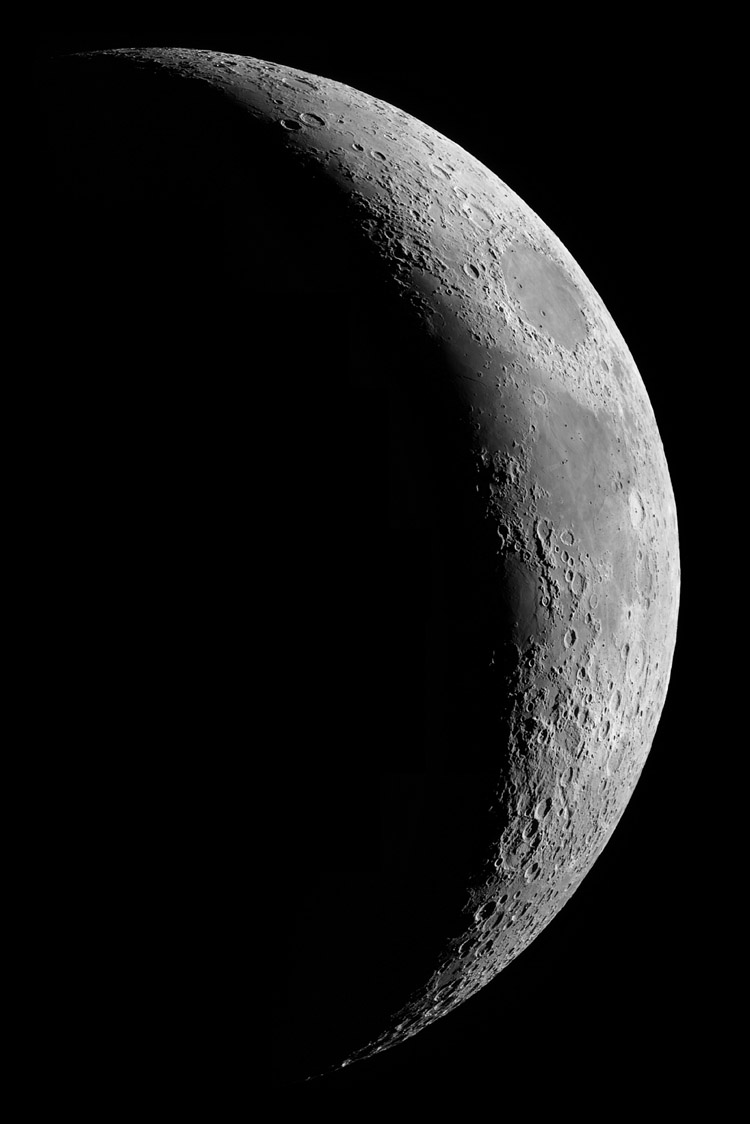January 3, 2009
Travelogue

image by Jim Ferreira, Livermore, California
This is the Moon of my dreams. A crisp crescent with hundreds of interesting landforms to investigate. Seeing a Moon like this in an early evening (hopefully warm) sky would cause me to pull out my 6" Intes Maksutov and a box of eyepieces. I'd start with a low power view taking in the entire Moon, just to enjoy the splendor and also to see exactly where the terminator is and what is well placed for observation. With a four day old Moon there are details visible all the way to the limb. So I would put it a 10 mm eyepiece to get 160 power and then start at the north end of the crescent and linger along the terminator all the way south. Atlas and Hercules are perfectly placed, with the rilles on the floor of Atlas just detectable. The skating rink floor of Endymion is smooth as ever (at least with this aperture). Keep moving down to rabbit-eared Burckhardt, Cleomedes, and the strange angled corner of northwest Crisium. At this lighting Proclus gives no hint of its brightness and vee'd rays. The twin fractures of the Cauchy Rille and Fault are on the terminator, as well as one of the domes south of the fault. Following the trend of the two fracture a little to the southeast is the peculiar crater Taruntius. (I always think of the Tarantara! tarantara! police song from The Pirates of Penzance when I think of that name). In western Fecunditatis are Messier and Pickering (I like the old names!) and the railway track of rays leading toward the terminator. The mare ridges step down the level of the floor of Mare Nectaris, and I can never see the rilles in Goclenius that Apollo 8 captured so gloriously. But the Petavius Rille is always visible, and I quickly check the splayed rays of Petavius B. In the home stretch now, with a glance at the three rings along the southern half of the Nectaris Basin, and it's radial Rheita Valley secondary crater chain. Finally, Janssen offers it's central rille-cut bulge and the curving rille on the crater floor - why is it there? Libration is poor but there is a little of the darkness of Mare Australe along the sotheast limb, and then the final slide along the terminator pass all the look-alike craters leading to the southern cusp. The seeing has been good enough to slip in the 4 mm eyepiece and repeat the journey...
Chuck Wood
Technical Details
Dec 31, 2008 (= 2009 Jan 01 from 02:00-02:15 UT). 3 inch APO + DMK21 camera; 8 frame mosaic.
Related Links
Jim's website (including full sized version of LPOD photo)
Yesterday's LPOD: A Lot of Nodding
Tomorrow's LPOD: Four* Heavenly Bodies And a Windmill
COMMENTS?
Register, Log in, and join in the comments.



